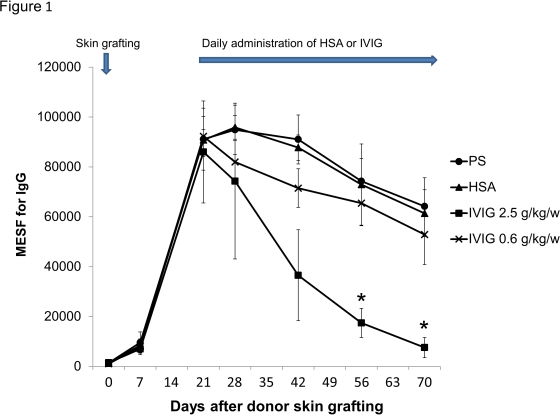Sequential Analysis of Donor-Specific Antibodies and Pathological Findings Using Intravenous Immunoglobulin in a Highly Sensitized Rat Kidney Transplant Model.
1Urology, Fukushima Rosai Hospital, Iwaki, Japan
2Urology, Tokyo Women's Medical University, Tokyo, Japan
3Pathology, Tokyo Women's Medical University, Tokyo, Japan
4Urology, Shizuoka General Hospital, Shizuoka, Japan.
Meeting: 2016 American Transplant Congress
Abstract number: A19
Keywords: IVIG, Kidney transplantation
Session Information
Session Type: Poster Session
Date: Saturday, June 11, 2016
Session Time: 5:30pm-7:30pm
 Presentation Time: 5:30pm-7:30pm
Presentation Time: 5:30pm-7:30pm
Location: Halls C&D
Intravenous immunoglobulin (IVIG) has evolved widespread use for treatment of acute antibody-mediated rejection (AAMR) and desensitization in highly HLA-sensitized patients. However, sequential change of the titers of donor-specific antibodies (DSA) through IVIG monotherapy remains largely unknown. In order to investigate the mechanisms of IVIG and sequential fluctuation of DSA titer, we administered high dose IVIG (2.5 g/kg body weigh per week) to sensitized recipient rats and measured the DSA-IgG levels sequentially. The levels of DSA-IgG in sensitized rats though IVIG gradually decreased, but it has taken 7 weeks following IVIG  . Those desensitized rats underwent kidney transplantation from the same donor strain. Then we evaluated sequential pathological findings based on the Banff classification and several factors related to IVIG. The C4d deposition in peritubular capillaries (C4d) and peritubular capillaritis (PTCis) in IVIG group were detected beginning 48 h and 72 h after transplantation, respectively. In contrast, both C4d and PTCis were already occurred 12 h after transplantation in presensitized (PS) group. Graft survival in IVIG group was significantly longer than that in PS group, but not in nonsensitized group. Additionally, BAFF serum levels successfully decreased, and significant in vitro production of IL-4, and in vivo increasing of proportion of regulatory T cells were observed in IVIG group. Thus, IVIG monotherapy can suppress the production of DSA-IgG and progress of AAMR, in a highly sensitized rat. However, it is insufficient to obtain complete desensitization, so that combination therapies which are targeting to memory B and plasma cells might be required.
. Those desensitized rats underwent kidney transplantation from the same donor strain. Then we evaluated sequential pathological findings based on the Banff classification and several factors related to IVIG. The C4d deposition in peritubular capillaries (C4d) and peritubular capillaritis (PTCis) in IVIG group were detected beginning 48 h and 72 h after transplantation, respectively. In contrast, both C4d and PTCis were already occurred 12 h after transplantation in presensitized (PS) group. Graft survival in IVIG group was significantly longer than that in PS group, but not in nonsensitized group. Additionally, BAFF serum levels successfully decreased, and significant in vitro production of IL-4, and in vivo increasing of proportion of regulatory T cells were observed in IVIG group. Thus, IVIG monotherapy can suppress the production of DSA-IgG and progress of AAMR, in a highly sensitized rat. However, it is insufficient to obtain complete desensitization, so that combination therapies which are targeting to memory B and plasma cells might be required.
CITATION INFORMATION: Sawada Y, Omoto K, Kohei N, Kawanishi K, Okumi M, Ishida H, Kazunari T. Sequential Analysis of Donor-Specific Antibodies and Pathological Findings Using Intravenous Immunoglobulin in a Highly Sensitized Rat Kidney Transplant Model. Am J Transplant. 2016;16 (suppl 3).
To cite this abstract in AMA style:
Sawada Y, Omoto K, Kohei N, Kawanishi K, Okumi M, Ishida H, Kazunari T. Sequential Analysis of Donor-Specific Antibodies and Pathological Findings Using Intravenous Immunoglobulin in a Highly Sensitized Rat Kidney Transplant Model. [abstract]. Am J Transplant. 2016; 16 (suppl 3). https://atcmeetingabstracts.com/abstract/sequential-analysis-of-donor-specific-antibodies-and-pathological-findings-using-intravenous-immunoglobulin-in-a-highly-sensitized-rat-kidney-transplant-model/. Accessed December 16, 2025.« Back to 2016 American Transplant Congress
